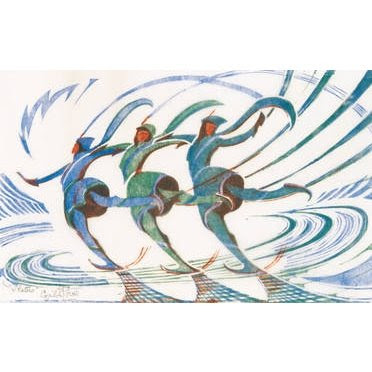 I went to the Metropolitan Museum of Art today for the first time. Along with visiting the permanent photography, Egyptian, Mesopotamian, impressionist, and modern art sections of the Museum, we made our last stop in the newest exhibit entitled Rhythms of Modern Life: British Prints 1914-1939. I was anticipating this all day, and usually when I think too much about something and build it up in my head it never turns out to be as wonderful as I hope. But this was just fantastic.
I went to the Metropolitan Museum of Art today for the first time. Along with visiting the permanent photography, Egyptian, Mesopotamian, impressionist, and modern art sections of the Museum, we made our last stop in the newest exhibit entitled Rhythms of Modern Life: British Prints 1914-1939. I was anticipating this all day, and usually when I think too much about something and build it up in my head it never turns out to be as wonderful as I hope. But this was just fantastic.The amount of effort that goes into each print is astounding, from the cutting of the material for each layer of color to the actual act of printmaking (thanks to my brother, I have screen printing experience, and let me tell you it's a laborious, repetitive and painstaking process).

Four or five artists were prominently featured in the exhibit, three of which were Edward Wadsworth, Sybil Andrews, and my favorite, Cyril E. Power. Power's work obviously made the biggest impression on me: all of the images featured in this entry were done by him. This printmaking movement in Britain represented a shift that contributed to Futurism, and the dynamism of each of these images evoke movement, industry, enhanced and warped perspective, and undeniable beauty. Hopefully this entry will inspire you to check out more stuff by Power and the others I cited in this entry. Another prominent artist whose images were full of vectors and geometric shapes was C.R.W. Nevinson, although I wasn't as impressed with his use of color as I was with Power.

This exhibit also brought thoughts of Benjamin to mind, since every one of these images is not the only one of its kind. Printmaking is an art form that can only be realized in an age of reproduction, yet that reproduction doesn't have to be mechanical. My experience with printmaking was done by hand. I understand that almost every printed t-shirt was made by a silk screen machine, but there are ways of making prints that are completely hand done. There was a covered display table in the center of one of the rooms that held the tools used to make a lithograph, which is indeed a very hands-on process, making printmaking seem to be more of a craft than a means of mass reproduction. There were two "identical" Cyril prints, each made from the same lithograph, side by side on the wall and the differences were astounding. Not one of any of these prints are identical, which I think adds to their individuality and thus their overall aura.

Another thing I loved about Power's work was that he signed, in pencil, each one of his prints, and also marked which number each print represented in the series. Not only did each print bare the mark of its maker, but these markings contributed a certain aura to an image that some might consider to be void of the presence of the artist. If you look hard enough, you can see all of Power's markings in the corners of his images.
4 comments:
That's a really inspiring review, makes me want to go see it!
Me, too! Will the exhibit still be there when we visit next month?
These prints are amazing! I am enjoying making crossovers between futurism and some of our class readings.
oh man. lithography is such an intense process. i'm always sore the next day after printing. but my what beautiful results they produce!
how long will it be at the met? or is it permanent?
Post a Comment